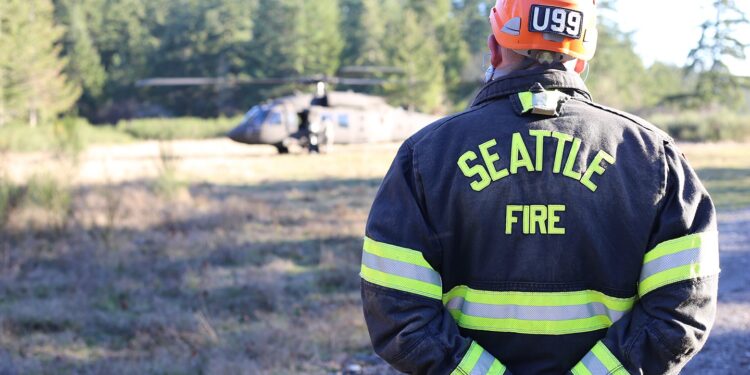Seattle Fire Department personnel participated in joint aerial rescue training with the Washington National Guard this week, practicing high-risk extraction techniques for natural disasters and high-rise building emergencies.
The exercise utilized a Blackhawk helicopter at a West Seattle training facility, where firefighters practiced being hoisted from structures and conducted simulated rescue operations involving mannequin victims.
Captain Mike Dulas of Seattle Fire Department emphasized the importance of regular training for these specialized skills. “This is a very perishable skillset, so we try to train with them at least four or five times a year,” Dulas said. “This is kinda high risk stuff so you need to be prepared and have a working knowledge.”
The training addresses potential catastrophic scenarios where National Guard assistance would be critical, including major earthquakes or flooding events that could require aerial evacuation from compromised buildings.
Firefighters rotated through exercises requiring them to be lifted and lowered via helicopter hoist systems. The culminating exercise involved being lowered onto a building rooftop to recover a training dummy, simulating real-world rescue conditions.
Chief Warrant Officer Jarin Trakel piloted the Blackhawk alongside another guardsman, describing the precision required for extended hovering operations. “It takes a lot to hover an aircraft for an extended period of time. It adds a more heightened responsibility when there are one or two [people] relying on you to not hit them into something else in a confined space or up against a guard rail or something,” Trakel explained.
Two crew members positioned behind the pilots maintain visual contact with firefighters during operations while operating hoist equipment. Trakel characterized the coordination as “a symphony of working with each other.”
Beyond technical skill development, the training builds crucial working relationships between agencies that would collaborate during actual emergencies. “It’s just helpful to know a familiar face when you’re on an incident and people are stressed, that they know what your capabilities are,” Dulas said.
The National Guard views these partnerships as essential to their domestic mission. “Our focus is domestic operations so we’re here to support the community in any way we can,” Trakel said. “This just adds on to what we’re able to add to the community.”
Seattle’s location near multiple geological fault lines and its numerous high-rise buildings make aerial rescue capabilities particularly relevant for emergency preparedness. The joint training ensures both agencies maintain readiness for scenarios where traditional ground-based rescue methods may be insufficient.
Such multi-agency exercises reflect broader emergency management strategies that integrate military and civilian capabilities for disaster response, ensuring seamless coordination when public safety demands immediate aerial intervention.






